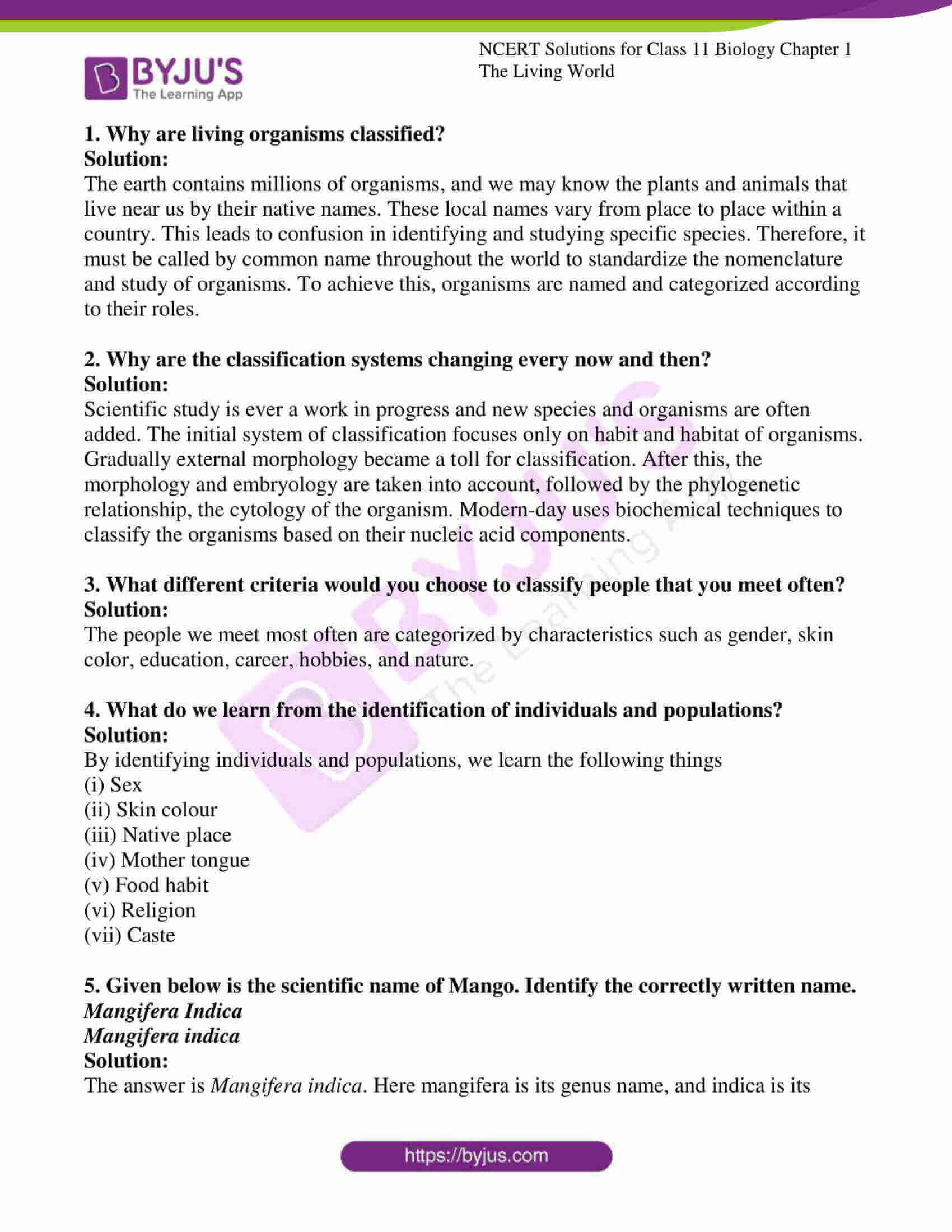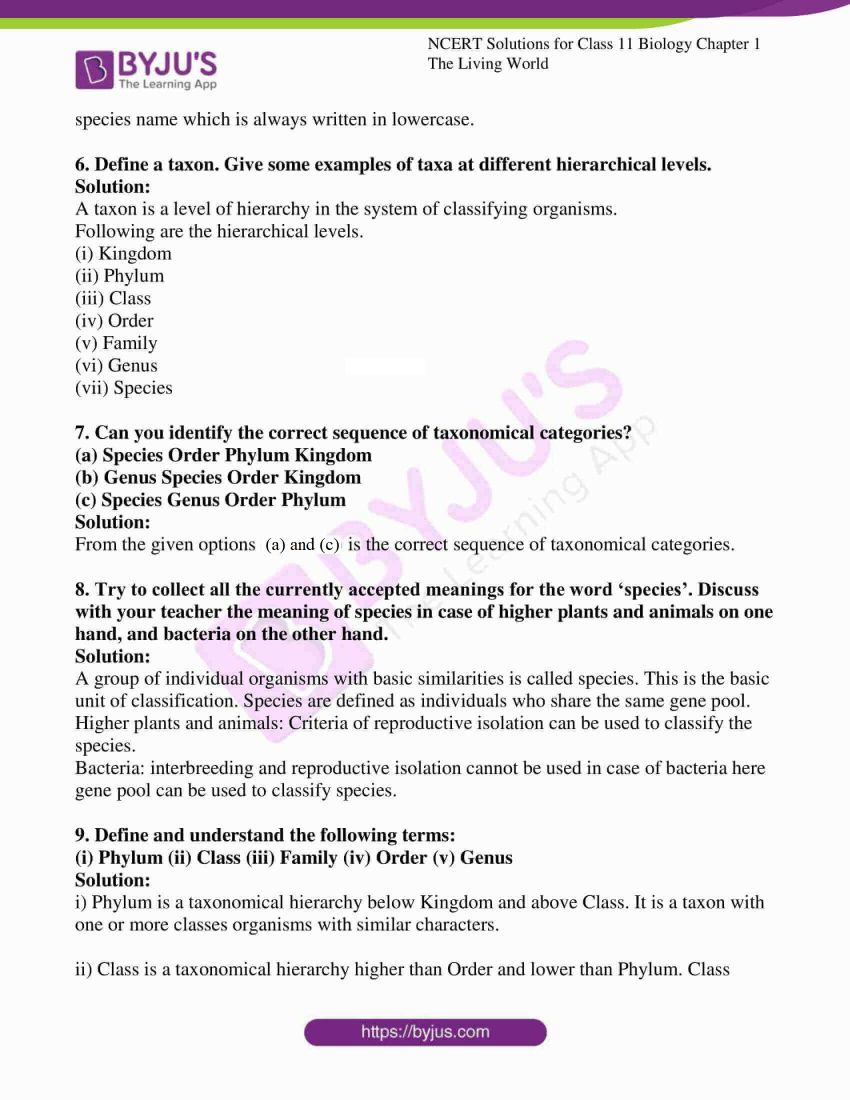NCERT Solutions for Class 11 Biology Chapter 1 – Free PDF Download
The NCERT Solutions for Class 11 Biology at BYJU’S presents students with precise solutions to all the exercise questions given in the NCERT Class 11 textbook. It aligns with the latest update of the CBSE Syllabus 2023-24. The Solutions of NCERT Class 11 Biology of this chapter is considered to be extremely helpful when preparing for students’ examinations as well as competitive exams. Solutions have been solved skillfully with the use of easily comprehensible language to help understand concepts and remember them for a long time.
Examinations can be intimidating for some students. Careful planning backed up by thorough and in-depth learning of concepts is a sure bet to crack the board examinations with flying colours. This is why students can always rely on NCERT Solutions for Class 11 crafted at BYJU’S. Here, solutions are framed by a panel of experts having in-depth knowledge in the respective streams, thereby making the NCERT Solutions for Class 11 Biology the ultimate study source.
One of the other advantages is that NCERT Solutions help students to get familiarised with the textbooks. These solutions can be accessed anywhere, anytime by students saving hours of browsing the web as well as skimming through the book for accurate and precise answers.
Download the PDF of NCERT Solutions for Class 11 Biology Chapter 1 – The Living World
Access Answers to NCERT Class 11 Biology Chapter 1 – The Living World
1. Why are living organisms classified?
Solution:
The earth contains millions of organisms, and we may know the plants and animals that live near us by their native names. The local names vary from place to place within a country. This leads to confusion in identifying and studying specific species. Therefore, it must be called by a common name throughout the world to standardise the nomenclature and study of organisms. To achieve this, organisms are named and categorised according to their roles.
2. Why are the classification systems changing every now and then?
Solution:
Scientific study is ever a work in progress, and new species and organisms are often added. The initial system of classification focuses only on the habits and habitat of organisms. Gradually, external morphology became a tool for classification. After this, the morphology and embryology are taken into account, followed by the phylogenetic relationship and the cytology of the organism. Modern-day uses biochemical techniques to classify organisms based on their nucleic acid components.
3. What different criteria would you choose to classify people that you meet often?
Solution:
The people we meet most often are categorized by characteristics such as gender, skin colour, education, career, hobbies, and nature.
4. What do we learn from the identification of individuals and populations?
Solution:
By identifying individuals and populations, we learn the following things:
(i) Sex
(ii) Skin colour
(iii) Native place
(iv) Mother tongue
(v) Food habit
(vi) Religion
(vii) Caste
5. Given below is the scientific name of Mango. Identify the correctly written name.
Mangifera Indica
Mangifera indica
Solution:
The answer is Mangifera indica. Here, Mangifera is its genus name, and indica is its species name which is always written in lowercase.
6. Define a taxon. Give some examples of taxa at different hierarchical levels.
Solution:
A taxon is a level of hierarchy in the system of classifying organisms.
Following are the hierarchical levels:
(i) Kingdom
(ii) Phylum
(iii) Class
(iv) Order
(v) Family
(vi) Genus
(vii) Species
7. Can you identify the correct sequence of taxonomical categories?
(a) Species Order Phylum Kingdom
(b) Genus Species Order Kingdom
(c) Species Genus Order Phylum
Solution:
From the given options, (a) and (c) is the correct sequence of taxonomical categories.
8. Try to collect all the currently accepted meanings for the word ‘species’. Discuss with your teacher the meaning of species in the case of higher plants and animals on the one hand and bacteria on the other hand.
Solution:
A group of individual organisms with basic similarities is called species. This is the basic unit of classification. Species are defined as individuals who share the same gene pool.
Higher plants and animals: Criteria of reproductive isolation can be used to classify the species.
Bacteria: Interbreeding and reproductive isolation cannot be used in the case of bacteria; here, a gene pool can be used to classify species.
9. Define and understand the following terms.
(i) Phylum (ii) Class (iii) Family (iv) Order (v) Genus
Solution:
i) Phylum is a taxonomical hierarchy below Kingdom and above Class. It is a taxon with one or more classes of organisms with similar characteristics.
ii) Class is a taxonomical hierarchy higher than Order and lower than Phylum. Class includes related to orders of the organisms. Example: Presence of notochord in mammals.
iii) Family has a group of related genera with still less number of similarities as compared to genus and species. Example: Fox and dog belongs to the same family. It is a group of entities below Order and above Genus.
iv) Order is a taxon below higher than Family and lower than class. Order being a higher category, is the assemblage of families which exhibit a few similar characters.
v) Genus comprises a group of related species which has more characteristics in common in comparison to species of other genera. Examples: Lion, tiger and leopard are classified under the genus Panthera. It is above species and below the family.
10. How is a key helpful in the identification and classification of an organism?
Solution:
The key is a taxonomic aid used to identify plants and animals based on similarities and dissimilarities. It represents the choice between two opposite characters. This is useful for identifying contrasting characters. They are two contrasting characters, where one character’s choice rejects another when the species, family, or genera is identified.
If the entity is not already recorded, efforts are made for the first verification and reconsider its discovery before naming it. Therefore, each entity can be classified as it is known or unknown.
11. Illustrate the taxonomical hierarchy with suitable examples of a plant and an animal.
Solution:
The table below depicts the taxonomic hierarchy with wheat as an example of a plant and humans as an example of an animal.
| Taxonomic categories | Wheat | Human |
| Kingdom | Plantae | Animalia |
| Phylum/Division | Angiospermae | Chordata |
| Class | Monocotylydonae | Mammalia |
| Order | Poales | Primata |
| Family | Poaceae | Homonidae |
| Genus | Triticum | Homo |
| Species | aestivum | Sapiens |
NCERT Solutions for Class 11 Biology Chapter 1 – The Living World
The Living World is the 1st chapter categorised under Unit 1 – Diversity in the Living World. Biology is the science of life forms and living processes. This living world embraces an astonishing diversity of living entities and is vastly distinct in the boundless differences in characteristics they possess. The extraordinary habitats in which living entities are found can be extremely cold conditions or extremely hot conditions, deciduous forests, freshwater lakes, oceans, hot springs and so on.
In NCERT Solutions for Class 11 Biology Chapter 1, students will learn reproduction, growth, and the ability to sense the environment and mount an acceptable response as soon as they think of salient features of living entities. A few other features can be added, namely, the ability to self-replicate, metabolism, self-organise, interact, and emergence also make it to the list.
This chapter discusses the details of diversity in the living world.
List of subtopics covered in Chapter 1 – The Living World:
| Number | Subtopic |
| 1.1 | What Is Living? |
| 1.2 | Diversity in the living world |
| 1.3 | Taxonomic categories |
| 1.4 | Taxonomical Aids |
NCERT Solutions for Class 11 Biology Chapter 1 – The Living World
In the NCERT Solutions of this chapter, we learn about different aspects of The Living World. It has a wide variety of plants and animals, even with what has been identified and described, whereas a larger number still remains undiscovered. Living entities vary in terms of colour, size, habitat, and morphological and physiological features making us seek the defining characteristics of the living.
Biologists have evolved certain protocols to identify, name (nomenclature) and classify organisms facilitating different kinds of study of diversity observed in organisms. This branch of knowledge that deals with various aspects of the classification of organisms is referred to as taxonomy.
Taxonomic studies and observance of different species of plants and animals are beneficial in a myriad of departments such as forestry, agriculture, industry, bio-resources and their diversity, etc. On the basis of distinct differences and resemblances, every organism can be identified and assigned an appropriate scientific or biological name.
Key Features of NCERT Solutions for Class 11 Biology Chapter 1 – The Living World
- NCERT Solutions for the chapter have been answered by extracting the most important and relevant information pertaining to the question
- Use of tabular columns wherever necessary
- Solutions are to the point and crisp
- Use of pointers to learn quickly and remember easily
- Solutions have been designed in such a way as to fetch optimum marks
Disclaimer –
Dropped Topics –
1.1 What Is ‘Living’?
1.4 Taxonomical Aids
1.4.2 Botanical Gardens
1.4.3 Museum
1.4.4 Zoological Parks Summary (Para 2)
Question no. 10
Frequently Asked Questions on NCERT Solutions for Class 11 Biology Chapter 1
Can the NCERT Solutions for Class 11 Biology Chapter 1 be considered the repository of important questions?
What are the benefits of referring to the NCERT Solutions for Class 11 Biology Chapter 1?
What are the important concepts covered in Chapter 1 of NCERT Solutions for Class 11 Biology?
1.1 – What Is Living?
1.2 – Diversity in the Living World
1.3 – Taxonomic Categories
1.4 – Taxonomical Aids
To understand concepts in a better way, students can refer to the NCERT Solutions created by the faculty at BYJU’S. The PDF format of solutions is available, which can be downloaded and used by the students based on their needs.



Very nice explanation
Good website for all students
Nice coaching classes
This is useful knowledge